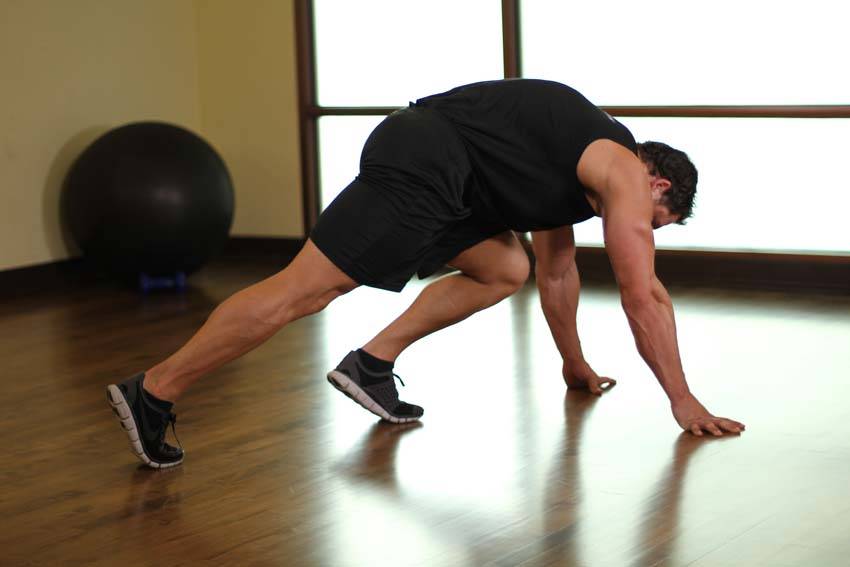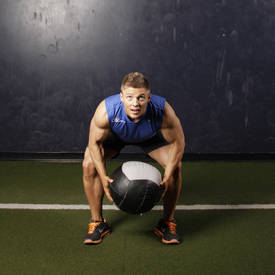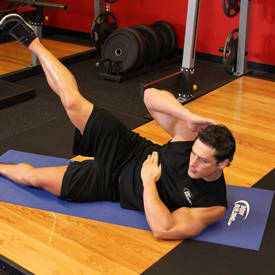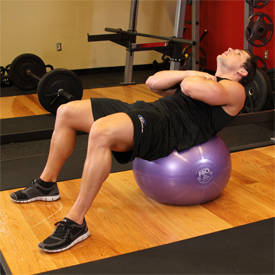WHAT IS THE BEST WORKOUT FOR STRENGTHENING OBLIQUE MUSCLES?
A lot of focus is placed on training abdominals, but many people forget their surrounding neighbors; the oblique muscles.
What is the best workout for strengthening oblique muscles?
Which sports would require strong oblique muscles?
Why are oblique muscles often not included in many workouts?
Show off your knowledge to the world!
THE WINNERS:
1ST PLACE DART12GR
OBLIQUE TRAINING!
When people think of abs, they think of the rectus abdominus, the muscle that, in combination with dieting and resistance training, creates the “six pack.” Much forgotten however are the oblique muscles, that run up and down our sides. Obliques serve as stabilizers, and are engaged in almost every compound lifting movement, and almost every physical activity. It is extremely important that they are strong. Obliques training is an important supplement to your ab workout, irrespective of whether they are visible. They act in the same was as the supplements found at Sculpt Nation help you maximize your diet plan of proper foods.
Many bodybuilders on the other hand have small waists tapered down from their lats. This achieves the appearance of a “V” shape and it is sought after in the bodybuilding world. While bodybuilders have strong obliques, there are strengthening exercises you can do that will not cause you to hypertrophy to a point where your obliques ruin your V-taper.
BEST EXERCISES FOR STRENGTH, POWER, & FUNCTION
EXERCISE 1 DUMBBELL OR BARBELL SIDE BENDS

EXERCISE 2 MEDICINE/SLAM BALL THROW

Simply throw your ball against a wall. You can use either medicine balls or slam balls. Stand a few feet away from a wall with your shoulder facing the wall. Holding a medicine/slam ball, twist your torso powerfully in order to throw it against the wall. Catch it when it comes back to you and repeat.
EXERCISE 3 WEIGHTED DECLINE OBLIQUE CRUNCHES

EXERCISE 4 PLATE TWIST

BEST EXERCISES FOR STRENGTHENING OBLIQUES & MAINTAINING A SMALL WAIST
EXERCISE 1 PUSH UP TO SIDE PLANK

EXERCISE 2 SEATED BARBELL TWIST

EXERCISE 3 SIDE JACKKNIFE

WHICH SPORTS REQUIRE STRONG OBLIQUE MUSCLES?
Which sports require strong oblique muscles? Which sports don’t require strong oblique muscles!
If you play any kind of contact sport, obliques are going to be a critical part of your overall ability to perform. No matter how much power you have, you will not be able to deliver it if you don’t have strong obliques on which to build your base. In contact sports, oblique muscles also protect your torso, and prevent damage to vital organs.
Any sport where you are required to run will call on the obliques for stabilization.
Rowing calls heavily on the obliques. They help you to balance the boat and allow you to deliver full power on the oar by stabilizing your body allowing all the necessary muscles to work and connect together.
In any sport where you have to twist your torso, such as shot-put, javelin, golf or tennis, oblique strength is paramount in delivering power.
In weightlifting the obliques are recruited heavily in lifts such as deadlifts, squats, cleans, and any vertical over-the-head movements such as over-the-head squats and standing military presses.
STOP NEGLECTING YOUR OBLIQUES!
Obliques are often neglected because for most people, they are not part of the “six pack.” In addition to this, it is difficult to diet down to a point where the obliques are in fact visible. Nevertheless, building strong obliques is infinitely beneficial to your training and over all health.
Many people who lift seriously might assume that they hit their obliques hard enough when they do heavy deadlifts or squats. Additional oblique training, could, however, work to improve the form of your lift, and even help to increase the amount of weight you can lift.
SAMPLE OBLIQUE WORKOUT TO BE DONE AT THE END OF A LIFT
Do not do abs/obliques before heavy lift because it could compromise your form. Note it is perfectly fine to mix and match the exercises from the two categories of oblique exercises*
BACKWARD MEDICINE BALL THROW
2 sets of 10 reps
SIDE JACKKNIFE
1 sets of 30 reps
DECLINE OBLIQUE CRUNCH
2 sets of 6-8 reps
SEATED BARBELL TWIST
2 sets of 25 reps
BACKWARD MEDICINE BALL THROW
2 sets of 10 reps
DECLINE OBLIQUE CRUNCH
2 sets of 6-8 reps
RUSSIAN TWIST
1 set of 20 reps each side
Exercises that require more weight should be done with less reps while movements like barbell twists do not require much weight at all and higher reps can be used.
2ND PLACE SOUNDCHECK129
A lot of focus is placed on training abdominals, but many people forget their surrounding neighbors; the oblique muscles.
Other than perhaps “Arnold,” the two syllables most frequently associated, in most of the general public’s minds, with being in excellent shape is “six pack.”
Often, many beginners are lured into the gym with dreams of arms and abs, and some can be so obsessed with maintaining a visible set of the latter that they fail to make progress anywhere else. And even with this ab obsession, many still fail to train their obliques effectively, which not only holds back their quest for attractive abs, but their overall strength and flexibility.
WHAT IS THE BEST WORKOUT FOR STRENGTHENING OBLIQUE MUSCLES?
Probably the biggest misconception about oblique training, and ab training in general, is that the key to success is volume. Sadly, people fail to understand that like every other body part trained in the gym, abs are muscles too, and the same rules apply. You wouldn’t do 300 sets of bench press and try to train your chest every day, so why should your abs and obliques be any different?
Well here’s the secret – they’re not. For this reason, I do direct ab training at most twice per week. If you’re performing compound lifts such as deadlifts and squats, your abdominals and obliques are getting stimulation from those as well. You’ll find greater success relying on weighted ab work performed just a few times per week rather than unweighted ab work performed daily.
Here is a routine I’ve used that has resulted in significant oblique development.
WARMUP
EXERCISE 1 BICYCLE CRUNCHES
1 SET OF 25 REPS

EXERCISE 2 MOUNTAIN CLIMBERS
1 SET OF 25 REPS

DUMBBELL SIDE BEND
1 set of 10 reps each side
EXERCISE BALL CRUNCH
1 set of 25 reps
RUSSIAN TWIST
1 set of 15 reps each side
JACKKNIFE SIT-UP
1 set of 15 reps
MEDICINE BALL FULL TWIST
1 set of 10 reps each side
SIDE BRIDGE
1 set of 30 seconds each side
This circuit can be repeated as many times as you want, but my personal feeling is that more than four times through is probably excessive. This is a solid routine because it does not require cable equipment or other machinery that most probably don’t have.
Any weighted object can be used for the V-Ups, Russian Twists and Side Bends, and it is easy to adjust this routine when you progress by bumping up the weight or number of circuits. Additionally, you can squeeze each circuit in between a few laps on the track or before and after your cardio/weight sessions to maximize efficiency.
WHICH SPORTS WOULD REQUIRE STRONG OBLIQUE MUSCLES?
It’s difficult to think of a sport that doesn’t require strong obliques. The obliques are essential in supporting the torso and back and allowing rotation and flexibility, which is important in any athletic endeavor. Having a strong torso and being able to control it as of particular interest to wrestlers and mixed-martial arts athletes, aiding them in engaging opponents and reversing out of holds and pins.
Baseball, football and hockey players can also benefit from strong obliques, as they often have to project the ball or puck in a different direction than the one they are currently facing. This entails a lot of flexibility and strength in the torso, a function of the obliques.
Baseball players, tennis players and hockey players wishing to put as much force as they can behind their shots/hits will also want strong obliques to aid spinal flexion and rotation. Football players also have to fight off tackles and stay on their feet to make plays even as opponents attempt to drag them down; having strong obliques allows them do just that.
WHY ARE OBLIQUE MUSCLES OFTEN NOT INCLUDED IN MANY WORKOUTS?
There are a few reasons that oblique muscles are not typically included in many workouts. One is that the obliques aren’t as visible as other muscles, especially their neighbors in the rectus abdominus. Obliques don’t form part of the coveted six-pack, so some choose to ignore them. Ironically, though, well developed obliques can actually enhance the look of the rest of the abdominals.
Another reason obliques are not included is because some are afraid that over-developed obliques will cause one to look as if they have a wide waist, possibly giving the appearance of being overweight. A wide waist detracts from the tapered torso that many bodybuilders and other fitness enthusiasts strive for.
Lastly, oblique exercises aren’t usually associated with overall strength, and the exercises aren’t usually fun, either. Because the mentality with ab exercises seems to be that abs must be trained with absurdly high volume and frequency, some just may not think the effort is worth it, figuring that strong obliques won’t improve one’s bench or curl numbers, so there’s no point.
However, high volume and high frequency isn’t the way to go – a couple weighted sessions per week is all you really need. Trust me – once you begin training your abs like your other muscles, they will begin developing like them.
3RD PLACE MRKDRT
A lot of focus is placed on training abdominals, but many people forget their surrounding neighbors; the oblique muscles.
“Obliques” are often missed out on most training programs. We all keep hearing how important core strength is, so why do so many people miss out on them? Are they really that important to train?
WHAT IS THE BEST WORKOUT FOR STRENGTHENING OBLIQUE MUSCLES?
I suggest training you obliques no more than once a week, and there’s no need to use heavy weight. Your obliques are put to use all the time to stabilize your frame, and surely you don’t want your daily activities or other workouts to suffer because you trained too hard. In this case, less is more.
Great exercises you can use to train your obliques are:
EXERCISE 1 OBLIQUE CRUNCHES ON THE FLOOR
3 SETS OF 15-20 REPS

When it comes to core, I feel higher reps are the way to go. This exercise trains the lateral flexion function. Really focusing on squeezing the oblique muscles through the movement, and maintain good form. Do not use momentum to complete the motion.
EXERCISE 2 BARBELL SIDE BENDS
3 SETS OF 15-20 REPS

EXERCISE 3 PLATE TWIST
3 SETS OF 15-20 REPS

EXERCISE 4 MEDICINE BALL FULL TWIST
3 SETS OF 15-20 REPS

EXERCISE 5 PUSH UP TO SIDE PLANK
1 SET FOR 1 MINUTE

If you’ve ever done “planks” you know how killer they are, especially finishing off your abs workouts. If you pass one minute and can still go on, great! Don’t forget though, you’ll still be doing the other side!1
Toss these exercises into your normal abs or “core” day. Or, you can even do them after exercising another muscle group. If you do train your obliques in the same workout as another, I recommend doing them at the end. This way your core won’t be exhausted for other exercises where they are crucial for good form.
WHICH SPORTS WOULD REQUIRE STRONG OBLIQUE MUSCLES?
Performing the exercises and feeling what area is targeted, you can guess pretty easy which sports’ athletes can benefit from stronger obliques. The twisting motion (rotation) is crucial in many sports like golf, baseball, football, and basically any throwing sport! I would imagine Hammer Throwers would have incredibly strong obliques.
Boxing, and more popularly MMA training definitely has training focused on obliques – for dodging punches and throwing punches. When throwing punches, the power starting in your legs can only be passed along to your fist with your core. And of course, many punches involve twisting and bending to increase power. Developing greater oblique strength can also translate to a more powerful punch – and fighters are ALWAYS happy to increase their “knockout power.”
Swimming is also a great way to lean out and make your obliques more visible. Don’t worry if you’re not a confident swimmer, no matter your age, swimming lessons are a great way to burn off stubborn fat and strengthen your core.
WHY ARE OBLIQUE MUSCLES OFTEN NOT INCLUDED IN MANY WORKOUTS?
Obliques of course, are a part of your core. Being your core, these muscle groups are put to use for almost any physical activity. Normally, other exercises – including the squat and the deadlift – work your core and can develop its strength. So isolation exercises targeting the oblique muscles would not always be necessary.
Of course, strengthening often comes with gains in size as well. With the obliques being on the outer ranges of your waist – this can mean a thicker waist. For the bodybuilder concerned mainly about an aesthetically pleasing physique, this is not always a goal one would strive for.
If you’re a bodybuilder or athlete looking for ways to boost your oblique workouts, you might want to do some research into steroid alternatives such as SARMs. A lot of people have found that these supplements allow them to go the extra mile during workouts and really turn their physiques around quickly. For more information, head to a site such as SARMs for sale and take a look at some of the different SARMs options available.
REFERENCES
___
http://www.bodybuilding.com/fun/best_oblique_workouts.htm
























